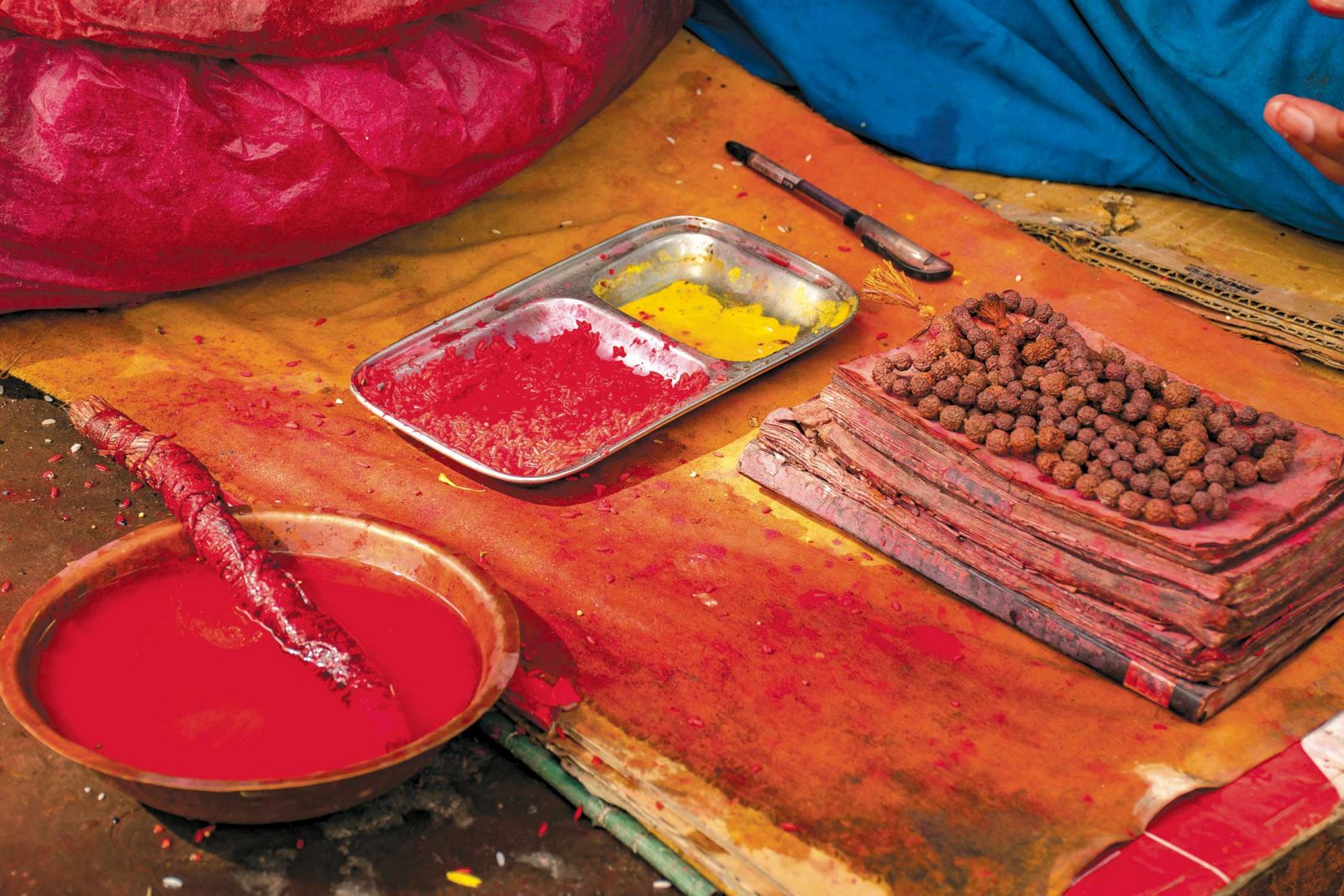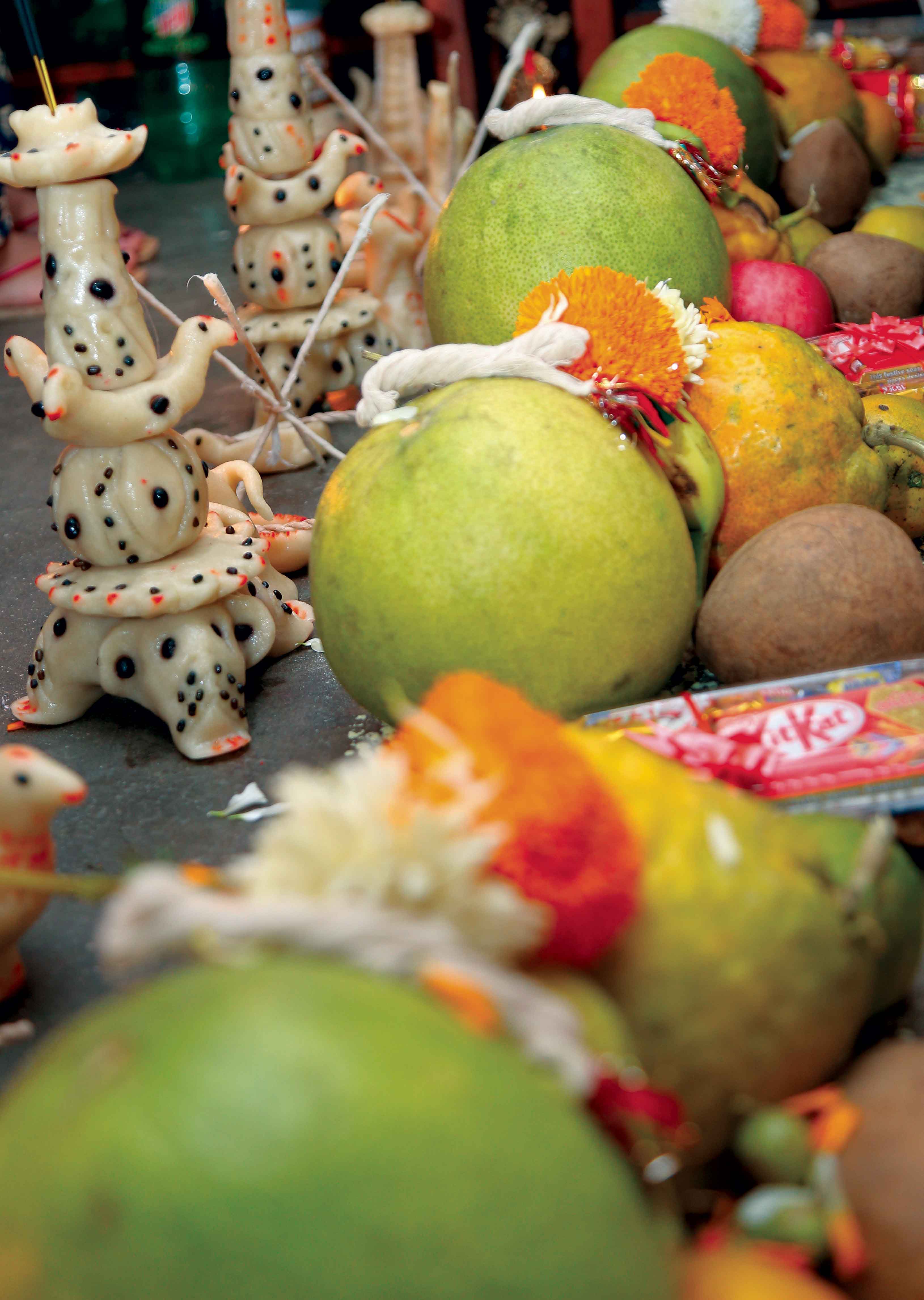
The months of July through October are referred to as the Chaturmas in Sanskrit, which according to the Hindu Lunar Calendar literally means four months. The deities of Hinduism are said to be resting during these 4 months, therefore no functions like weddings happen over this period. The Chaturmas, however, has the largest number of festivals observed in both Hinduism and Buddhism, and is considered a time for veneration, fasting, taking vows and visiting temples.
The first festival during the Chaturmas is the Harisayani Ekadashi; or the day Hari/Lord Visnu starts his resting phase, reclining on the coils of the serpent, Ananta Shesha, floating on the Kshreer Ocean. On this day followers of Hinduism or Sanartan dharma plant tulasi (a type of basil) seedlings in the vicinity of their households. The tulasi plant is considered a holy plant as it is very dear to Lord Visnu. Legends also mention that the plant emits positive energy, thus purifying its periphery. Before taking his rest, Lord Visnu is said to have requested that Lord Siva take over his duties as the preserver of the universe during his resting period. Thus in this first month of Sravana (July-August) devotees of Siva spend the whole month as vegetarians, visiting temples as a mark of reverence to the Lord.
The next festival is Guru Purnima, or the day to pay reverence to our teachers on this full moon. This day is celebrated more as a social festival than religious. However its observance fulfills religious duties in Hinduism too. On this day we pay back our debts to our gurus or teachers, who are the ones who enlighten us with knowledge. School children and college students alike perform entertaining events for their teachers in schools, whereas adults visit their teachers with gifts as a sign of respect and reverence.
The next festival is the Gathamuga or the festival in which evil forces in the form of demons like Ghantakarna are destroyed. The Newar communities lure the demons out of their homes by placing plates of cooked food at crossroads. In the evening effigies of the demons are burnt, symbolizing their end. On this day, people also buy and wear metal rings on their fingers, as a protection against evil.
A month long festival of Gunla is observed in the ninth month of the Newar Calander, which falls mostly in August. This festival is observed by the Newar Buddhist community of the Kathmandu Valley, and gets its name from the different traditional instruments that are played every morning as the community make pilgrimage around main temples and stupas or chaityas, chanting prayers and reciting scriptures. A visit to Swayambhu in Kathamndu or Patan Durbar Square premises in the early morning before 8 am finds the vivid sight of young girls and boys playing melodious spiritual tunes on traditional instruments, some groups singing and dancing, some chanting scriptures. Such displays of cultural traditions are a marvel of their own. On the first day of the second fortnight of Gunla, viharas display their images of dieties and paubha paintings to all who come to view them, in a ceremony known as Bahidyah Bwayegu.
Varaha Jayanti is another festival that falls in the period of Chaturmas. Varaha, or the boar avatar of Lord Visnu is said to have been manifested on this day to save the world from drowning. The religious scriptures, Rig Veda, tells how the demon Hiranakshya had stolen the earth and was in the process of sinking it in the ocean. Varaha then dove into the sea and rescued the earth by placing it on his tusks and swimming back to place her where she belonged. A large life size image of the Varaha avatar with the earth as a beautiful woman resting on his shoulders is in a temple at Chandole, Kathmandu.
The festival that follows this is the Naag Panchami, or the day dedicated to the serpents. In Hinduism, serpents are revered as protector deities. Thus small colorful drawings of snakes are pasted at main entrances of houses and venerated to protect these homes for the year. The following year, new drawings replace the old ones.
The next in this parade of festivals is Janai Purnima, the day to change the sacred thread worn by the priestly class of Hindus, the Brahmins. Others visit temples to have a sacred yellow cord tied around their wrist by priests. This sacred cord is supposed to function as a protector. On the same day, the Newar community celebrate Kwati-Puni or the full moon day when a scrumptious soup made by mixing nine or more pulses is cooked and consumed with family and relatives. This festival is observed to prepare the body for the forthcoming the cooler climate. In the Newari language kwa means hot and ti means soup.
A very popular festival that follows is Gaijatra. This is a unique festival celebrated only by the Newar community. On this day, fanciful and humorous processions are made by families who have lost a member in the current year. All these families gather and make a long procession, passing through the main palace complex and other parts of the old city. This festival is known to have been started by King Pratap Malla of Kathmandu to console his queen on the death of their beloved son. The humor and fanfare of this day took an extended form, morphing into day for freedom of speech, during the times when that right was under surveillance. In recent times the LGBT group also use this day to voice their opinions and rights.
The next to come is the Krishnaashtami, or the birth of Lord Krisna. Lord Krisna is the 7th incarnation of Lord Visnu. His birth has special significance because he was born to kill the demon King, Kamsa. The temples of Lord Krisna are decorated with cradles in which the image of baby Krishna is placed and people get to swing the cradle of the Lord. Vegetarianism is mostly observed, and after visiting the temples and receiving blessings from the god, people celebrate with good food shared with family and friends.
Towards the end of August falls the Fathers Day, in Nepali called ‘Buwa ko mukh herna din’ literally translated as the day to look at father’s face. This falls on the no moon day, and children cleanse themselves and visit their fathers with loads of goodies and gifts. Those who have already lost their fathers visit temples and make offerings to the needy. The temple of Gokarneswara in Kathmandu is visited by those who have lost their fathers, similarly the temples of Varaha Kshetra in Sunsari, Betrawati in Rasuwa and Devghat in Tanahu are also visited.
The day when most villages, towns and cities of Nepal are colored red by beautifully clad women attired in their best red garb and jewelry, holding a plateful of offerings at Siva temples, indicates the Teej festival has arrived. A lot of dancing and singing also happens while standing in queues at temples. For the prosperity and longevity of their spouse and family, Nepalese women undertake the fast of teej and only break their fast the next day after rituals to seven sages or Rishis on the day of Rishi Panchami are made.
Towards mid- September, when the monsoons are almost over and the skies are blue, colorful kites begin to dot the clear sky, heralding the festival of Indra Jatra, celebrated to appease Lord Indra, who had descended to earth from Heaven to collect the parijat flower for his mother. Mistaking him for a thief, earth dwellers tie Lord Indra in the garden. Knowing this, Lord Indra’s mother comes to his rescue and thus this festival is celebrated to appease him. The erecting of a pole at Basantapur Durbar Square and the mask dance at Indrachowk are an integral part of the festival.
Closely following Indra Jatra is the biggest festival of Nepal, Dasain, ie ten days of worshipping the nine very powerful goddesses or Navadurgas. This festival celebrates the defeat of evil in the form of the half man, half buffalo demon called Mahisasur by the all-powerful Goddess Mahisasurmardini, a manifestation of Parvati. Dasain is celebrated by Nepali people all across the country. Many visit their parents and perform the rituals together with their families. On the tenth day, people visit their elders and receive the red tika on their forehead and blessings. A lot of gambling and partying happens during this festival.
Following a few weeks after Dasain is the festival of Tihar. This is a five day event, celebrating the harmony of humans with other creatures like the cow, dog and crow as well as the environment. On the fourth day, the Goddess of Wealth, Lakshmi is worshipped by the cleaning of homes and showing her the route to enter and bless individual houses by decorating them with marigold flowers and lighting oil lamps. On the fifth day, a special ritual is celebrated, cherishing the relations of brothers and sisters. Sisters make prayers for the well-being and prosperity of their brothers and offer them trays full of goodies. In return brothers bring gifts for their sisters. The celebration culminates with feasts among family and friends. In between the five days of Tihar, the Newar community celebrate a unique festival called Maha-puja in the evening. Maha means the self, so on this day, mandalas are made on the floor representing the universe, and each person sits in front of their mandala which is decorated with colorful flour, oil lamps and flowers. People cleanse themselves, asking forgiveness for the year’s sins and pray for a prosperous new beginning. During the daytime, one can observe processions celebrating the New Year of the Nepal Samvat Calendar followed by the Newar Community.
Following Tihar is the festival of Chaat, celebrated by the Tharu community who live in the southern, or Terai, region of Nepal. However in recent times, with internal migration more common, Tharus have begun to celebrate it in their new habitations and do not necessarily visit their ancestral homes for the festival. They take a dip in the holy river at dawn, making offerings to the sun god, asking him to rid them of all their illnesses.
Towards the end of October, the Bodhini Ekadashi is celebrated to culminate the Charturmas or the four months when Lord Visnu rests. Lord Visnu rises from his celestial sleep and resumes his duties as the preserver of the universe. From this day onwards auspicious days are sought for weddings and other rituals of rites of passage. A new set of festivals begin, the elder generation trying to provide a continuity to this rich cultural heritage and the youngsters dodging time from work to be a part of the celebration.
Note: this article covers only major festivals that fall in the Chaturmas, many smaller ones could have been missed.
The author is a scholar in Nepalese culture, with special interest in art & iconography. She can be reached at swostirjb@gmail.com


A new hangout for cold-pressed juice connoisseurs
Instagram is...










